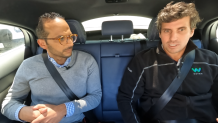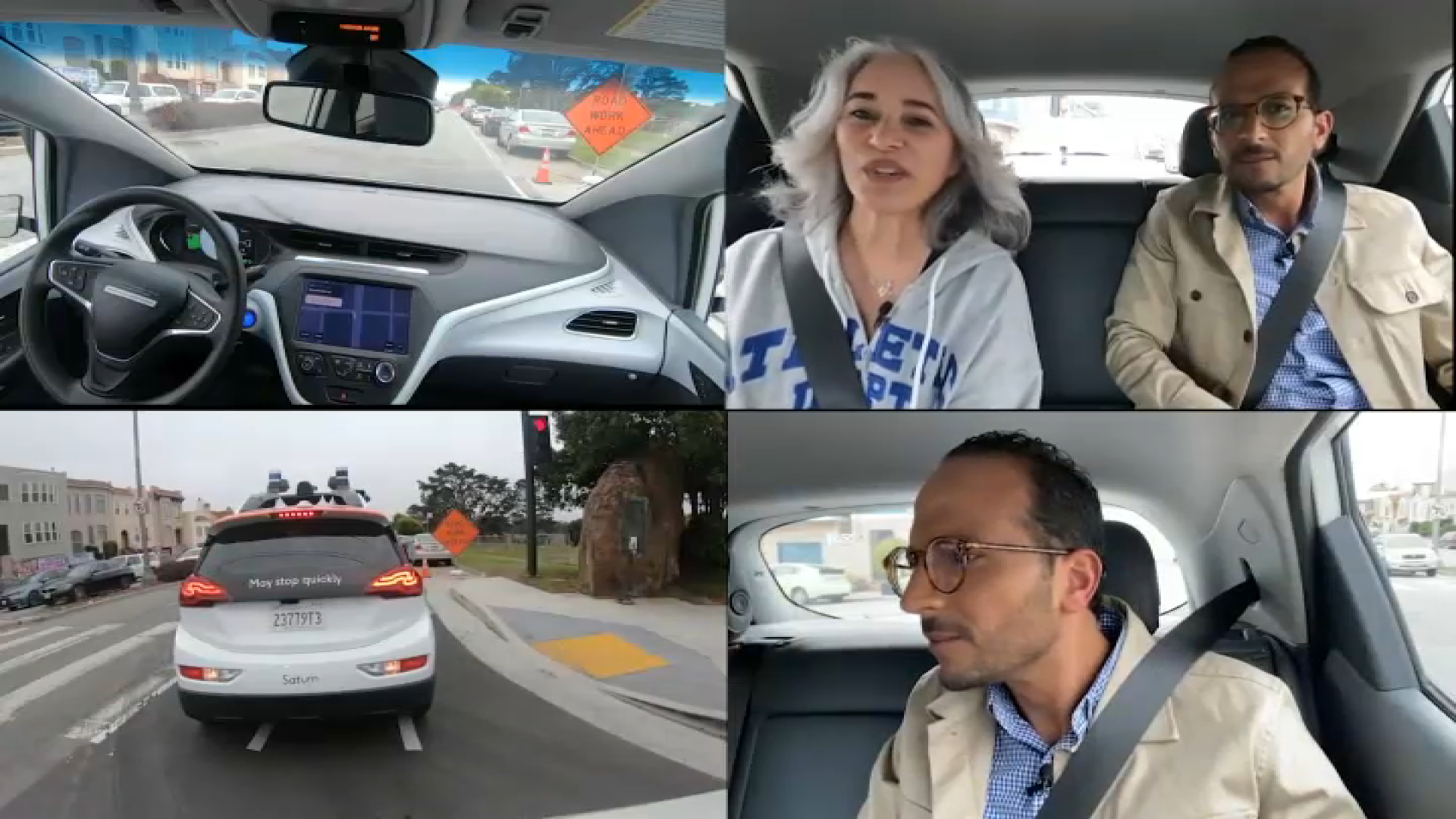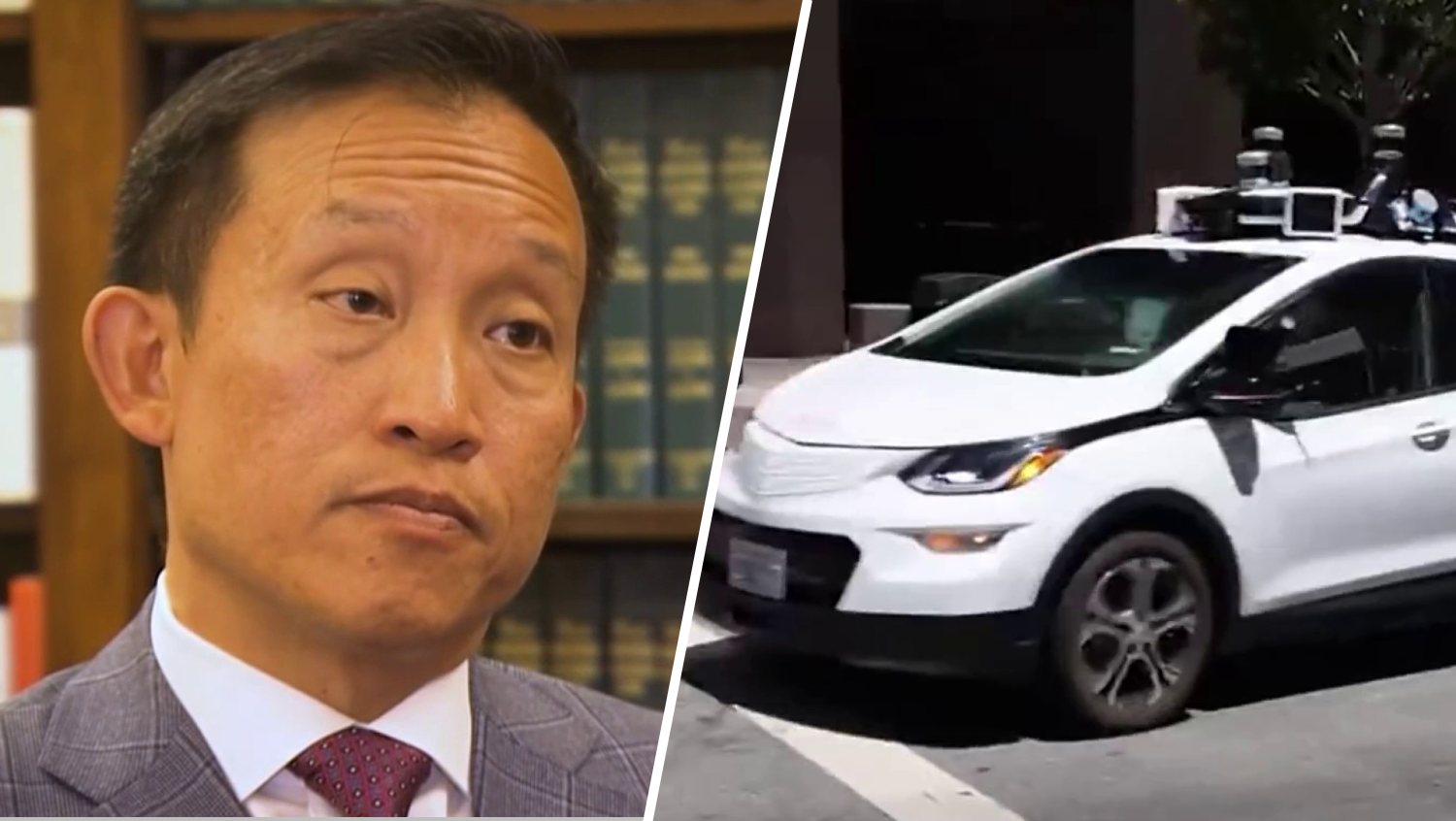Mounting concerns over self-driving cars – headlined by allegations autonomous vehicle maker Cruise misled the DMV about an accident in San Francisco that left a pedestrian seriously injured – have some questioning whether the state needs new laws and new watchdogs to govern the technology’s rapid expansion.
City streets currently serve as testing grounds for hundreds of self-driving cars in California, despite ongoing safety concerns and gray areas surrounding law enforcement’s ability to cite robot cars when they violate traffic laws.
I think all of us are still struggling to understand whether they really are safer than human drivers, and in what ways they might not be.
Irina Raicu, Director of the Internet Ethics program at the Markkula Center for Applied Ethics at Santa Clara University
“I think all of us are still struggling to understand whether [driverless cars] really are safer than human drivers, and in what ways they might not be,” said Irina Raicu, Director of the Internet Ethics program at the Markkula Center for Applied Ethics at Santa Clara University.
Autonomous vehicle makers say their cars need to keep logging miles to improve the technology and make the cars safer. As Raicu points out, however, much of the testing is happening on city streets alongside human drivers and pedestrians, and there’s still much we don’t know about how the vehicles perform.
“It seems like while they make fewer of the kind of mistakes that we see from human drivers, they make interesting new kinds of mistakes,” Raicu said. “It has the feel of a human subject mass experiment, right? Without the kind of consent that we usually want to see as part of that.”

Driverless double standard
Get a weekly recap of the latest San Francisco Bay Area housing news. Sign up for NBC Bay Area’s Housing Deconstructed newsletter.
Driverless cars have been documented running red lights, blocking emergency responders, and swerving into construction zones.
But when driverless cars break the rules of the road, NBC Bay Area has learned there’s not much law enforcement can do. In California, traffic tickets can only be written if there is an actual driver in the car.
An internal memo from San Francisco Police Chief Bill Scott, obtained by the NBC Bay Area Investigative Unit, instructs officers that “no citation for a moving violation can be issued if the [autonomous vehicle] is being operated in a driverless mode.”
Technology evolves rapidly and, at times, faster than legislation or regulations can adapt to the changes.
Chief Bill Scott, San Francisco Police Dept.
Scott adds, “Technology evolves rapidly and, at times, faster than legislation or regulations can adapt to the changes.”
While autonomous vehicles in California have received parking citations, the state’s current transportation laws appear to be leaving driverless vehicles immune from receiving any type of traffic ticket stemming from a moving violation.
“I think it sends a message that it’s not a level playing field, that fairness is not the priority,” said Michael Stephenson, founder and senior attorney of Bay Area Bicycle Law, a law firm that specializes in representing cyclists in accident cases.
Stephenson says driverless vehicles don’t exactly fit into the state’s current legal framework, and says California needs new laws to appropriately govern the evolving technology.
We're perhaps trying to shove a square peg into a round hole
Michael Stephenson, a long-time attorney, describes the inability of current traffic laws to address the evolving technology of driverless cars
“We’re perhaps trying to shove a square peg into a round hole,” Stephenson said. “We are very much in the wild west when it comes to driverless cars.”

Texas, Arizona rewrote traffic laws to allow ticketing of driverless cars
While driverless cars in California may seem to benefit from traffic ticket immunity, that is not the case for autonomous vehicles in Texas.
The Lone Star state, which rivals California as another popular testing ground for autonomous vehicles, changed its transportation laws in 2017 in order to adapt to the emerging technology. According to the Texas Transportation Code, the owner of a driverless car is “considered the operator” and can be cited for breaking traffic laws “regardless of whether the person is physically present in the vehicle.”
Arizona, another busy site for autonomous vehicles, took similar steps. In updating its own traffic laws, Arizona declared the owner of an autonomous vehicle "may be issued a traffic citation or other applicable penalty if the vehicle fails to comply with traffic or motor vehicle laws."
Waymo Product Management Director Chris Ludwick acknowledged the technology isn’t perfect, but says Waymo’s own research has shown its fleet of driverless cars are already “safer than human drivers.” A study recently released by Cruise noted similar findings when comparing crash rates of human drivers with its own autonomous vehicles.
“While there have been examples pointed out where driverless cars continue to need to improve, we can keep doing that,” Ludwick said. “And when we make an improvement once, that’s fixed in our system -- the whole fleet gets better. And so the technology is only getting better from here and it’s already really good.”
Neither Waymo nor Cruise has experienced a single traffic-related death after traveling more than 5 million driverless miles. But some question whether that’s enough of a track record since human drivers, on average, cause one death about every 100 million miles driven, according to the National Highway Traffic Safety Administration.
“Whether the police department has the jurisdiction to cite a driverless vehicle, we certainly do everything we can to ensure the car’s behavior is good,” Ludwick said. “I think the reality is that autonomous vehicles are being held to the highest standard.”
Related stories

Lawmaker presses for more oversight of driverless car industry
Yet, some question whether the state needs to reassess how it regulates the industry.
“We’re using the public square basically as a laboratory for trial and error,” said Sen. David Cortese (D-San Jose), who recently launched a probe into how the DMV both issues and revokes permits for driverless car companies in California.
Cortese says his investigation is also focused on safety standards as well as recent issues involving Cruise’s fleet of driverless cars.
Cruise’s fleet of driverless cars remain off the road
It was just three months ago when state regulators gave the green light for GM’s Cruise and Google’s Waymo to expand, and start collecting fares as their fleets of robo-taxis shuttle passengers across San Francisco.
But last month, Cruise parked all 400 of its driverless vehicles across the country without any mention of when the company might be able to dispatch them once again. While the move was voluntary in Arizona and Texas, Cruise was forced to take its vehicles off the road in California after regulators determined Cruise’s driverless fleet posed an “unreasonable risk to public safety.”
The move stemmed from an Oct. 2 accident, in which a hit-and-run driver in San Francisco struck a pedestrian, launching the woman into the direct path of a Cruise driverless vehicle, which then ran the woman over. After coming to a complete stop, however, the autonomous vehicle then started up again and attempted to pull over to the side of the road while the pedestrian remained trapped underneath the car, dragging the woman 20 feet. According to the DMV, Cruise attempted to hide video evidence relating to the attempted pull over that was recorded by the vehicle’s own camera system. The DMV maintains Cruise, originally, only showed state investigators video of the accident up until the moment the car came to its initial stop after running over the pedestrian, omitting the rest of the clip – including footage of the Cruise car dragging the trapped pedestrian.
"Footage of the subsequent movement of the [car] to perform a pullover maneuver was not shown to the department and Cruise did not disclose that any additional movement of the vehicle occurred after the initial stop of the vehicle,” the DMV wrote in a statement.
Cruise denies ever withholding the full video from the DMV. In fact, a spokesperson for the company says the entire clip of the accident, including the portion showing the Cruise car dragging the pedestrian, was shown to DMV officials several times on Oct. 3, just one day after the accident. Cruise says several days later, when the DMV requested a copy of the video, Cruise provided DMV officials with the very same video it had shown DMV investigators just ten days earlier.
Since then, Cruise has created a new Chief Safety Officer position and is hiring a consulting firm to conduct a “full assessment” of “safety operations and culture.”
Cruise CEO resigns as company remains under two separate investigations stemming from safety concerns
On Sunday, Cruise’s CEO and co-founder Kyle Vogt resigned. The company, which remains under investigation by both state and federal regulators over safety concerns, declined an interview request from NBC Bay Area.
In a recent statement, the company said, “The most important thing for us right now is to take steps to rebuild public trust. Part of this involves taking a hard look inwards…even if it means doing things that are uncomfortable or difficult.”
Cortese said the state needs to strike the right balance between ushering in innovation and protecting public safety and told NBC Bay Area that California may need an entirely new regulatory agency purely focused on driverless cars and artificial intelligence.
“Like when we got the FAA years ago, we’re going to have to do that here,” Cortese said. “And in order to do that here, we need to get started yesterday.”
State lawmakers have already attempted to pass new laws around driverless vehicles, but a recent effort didn’t make it past the Governor’s desk.
A bill requiring driverless trucks weighing more than 10,000 pounds to always have a safety driver inside the cab received bipartisan support in the state legislature earlier this year, but Governor Newsom vetoed it, calling it “unnecessary” since current laws already allow the DMV “to create the appropriate regulatory framework.”
The California DMV says it’s currently working to update regulations across the industry in hopes of requiring more oversight of driverless cars, although the agency won’t disclose what those new rules could look like.
“DMV held public workshops with interested stakeholders in January and July of 2023 to discuss topics which will inform the development of potential future rulemaking,” a DMV spokesperson wrote in a statement.
“DMV recognizes that autonomous technology is an evolving technology and remains committed to enhancing the regulatory structure to reflect the continued development of the technology.”
Watch our entire investigative series
- Part 1: Driverless cars seek San Francisco expansion despite worries tech is unsafe
- Part 2: CPUC votes to expand driverless car operations in San Francisco
- Part 3: San Francisco city attorney files motion to pump the brakes on driverless cars
- Part 4: Google's Waymo says insurance data shows its driverless cars are safer than humans
- Part 5: Hit-and-run driver strikes pedestrian, tossing her into path of Cruise car in San Francisco
- Part 6: Driverless trucks and robot deliveries promise fewer traffic jams than robotaxis
- Part 7: Cruise says its robotaxis can now better detect emergency vehicles
- Part 8: California DMV orders Cruise's driverless cars off the road
- Part 9: Driverless cars immune from traffic tickets in California under current laws
- Part 10: GM's Cruise lays off nearly 25% of its workforce
- Part 11: Waymo's driverless cars surpass 7 million miles, but are they safer than human drivers?
- Part 12: Cruise probe blames poor internet, bad leadership, and "flawed" decisions for company's woes
- Part 13: Driverless Cruise car accused of almost hitting 7 yr old after similar close call involving kids
- Part 14: Cruise offers to pay $112,500 in fines to settle claims driverless car company misled regulators
- Part 15: Uber Eats now uses Waymo Self-Driving cars to offer driverless deliveries
- Part 16: Bills aimed at closing traffic ticket loophole for driverless cars get initial green light
- Part 17: School crossing guards say they've had to dodge driverless cars to avoid being hit
- Part 18: Cruise ordered to pay $112,500 in penalties for withholding info from regulators
- Part 19: Waymo waitlist over in SF, all can hail driverless cars
- Part 20: SF Mayor vows to hold driverless car companies accountable after NBC Bay Area report
- Part 21: San Francisco govt. officials meet with Waymo to discuss safety concerns near schools
- Part 22: California DMV gears up to allow driverless trucking despite calls to restrict high-tech big rigs
- Part 23: Cruise to abandon robotaxi business after tumultuous year
- Part 24: Waymo's robotaxis surpass 25 million miles, but are they safer than humans?
Contact The Investigative Unit
submit tips | 1-888-996-TIPS | e-mail Bigad
Contact The Investigative Unit
submit tips | 1-888-996-TIPS | e-mail Bigad




